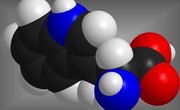When you see a cell under a microscope, it’s difficult to imagine that cell eating food the same way that we chow down on a cheeseburger and fries. And while cells certainly don’t have a set of teeth that gnaws into food, cell energy comes from the food we give them through our food and beverages. In similar ways, plant and animal cells take energy from their own types of food sources, such as rainfall or bales of hay, in order to stay alive and healthy. Learning more about how cells consume and use that energy can give you a better understanding of why cells need food to sustain life on this planet.
TL;DR (Too Long; Didn't Read)
Cells turn to a wide variety of food sources in order to receive the energy they need to perform the basic functions that make them the building blocks of life.
Energy for Cells
Cells need energy in order to survive and thrive. In all living organisms, anywhere from one cell to trillions of cells work together to perform the functions that animals, plants and humans need to stay alive. For this reason, they are often known as life’s building blocks.
Some of the important jobs they help to facilitate include providing structure for bodies, creating tissues, bolstering the immune system, converting nutrients into energy and transporting those nutrients to where they need to go. In many different types of plants, cells are responsible for enacting photosynthesis, the process that gives us the oxygen we need to live. For all of these jobs, they need energy that comes from various food sources.
Breaking Down Energy for Food Cell
Many people wonder which molecule is used by cells as an energy source. There are a few different types of molecules, but the most common is adenosine triphosphate, otherwise known as ATP.
Read more about the structure and function of adenosine triphosphate.
The ATP molecule is found in all forms of life on Earth. It has earned itself the nickname of “energy carrier,” since it is often responsible for storing and transporting energy within cells. All of that energy started as food, though, so without that initial food source, a cell would not be able to create or use ATP.
Human Food Cell Sources
Cells are able to receive energy from a wide variety of sources, depending on the type of organism that they are a part of. There is no magic food cell that controls the food function. Instead, different types of cells work together to collect, break down and store the energy that they receive from their food sources.
You’re probably most familiar with food sources for your own human cells. Our cells break down the sugars, fats, carbohydrates and proteins found in our food and convert them into the energy they need to keep our bodies going. They operate best when they have a steady diet with a healthy blend of those nutrients. That’s why you might feel sluggish, short-tempered, light-headed or find it hard to concentrate on days when you don’t eat much, or don’t eat a well-balanced diet.
When human cells don’t have much food, they turn to the lipids, or fat, that is stored within our bodies for their energy. This is the basic concept behind limiting your diet to lose weight -- with fewer food sources, cells will start to use up the stored fat, thereby ridding them from your body. However, too much diet restriction can lead to serious health consequences, and so should only be done with recommendation from a doctor.
Read more about where lipids are located in the body.
Plant and Animal Food Cell Sources
The food source for most plants is the sun. Photosynthetic cells work to harness that solar energy and then convert it into the nutrients that the other plant cells use to make sure the plants grow, store energy and reproduce.
As you can imagine, animal cell food sources vary wildly. Whether it’s a panda chomping down on bamboo or a lion hunting its prey, though, the cells within those animals require some type of food source in order to stay alive.
References
About the Author
Rachelle Dragani is a freelance writer based in Brooklyn with extensive experience covering the latest innovation and development in the world of science. Her pieces on topics including DNA sequencing, tissue engineering and stem cell advances have been featured in publications including BioTechniques: the International Journal of Life Science Methods, Popular Mechanics, Futurism and Gizmodo.
